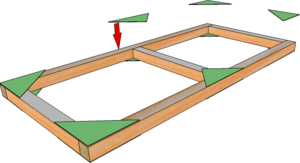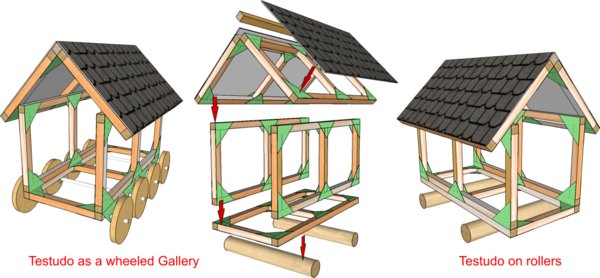Testudo (model): Difference between revisions
From DT Online
mNo edit summary |
mNo edit summary |
||
| (2 intermediate revisions by the same user not shown) | |||
| Line 24: | Line 24: | ||
* Assemble the frames together and glue with '''[[Glues and Pastes|P.V.A.]]''' glue | * Assemble the frames together and glue with '''[[Glues and Pastes|P.V.A.]]''' glue | ||
* Add a 210mm long strip of wood as a ridge | * Add a 210mm long strip of wood as a ridge | ||
* Search for suitable textures using the internet ''(e.g. search for 'woven twigs' using Google Images)'' and print-out on to thin card. | * Search for suitable textures using the internet ''(e.g. search for 'woven twigs' using Google Images)'' and print-out on to thin card ''(<dtamazon type="search" search="1:12th scale cladding paper">many suitable pre-printed papers available from '''HERE'''</dtamazon>)''. | ||
* Cut card rectangles to cover roof panels ''(and sides if required)'' then glue in place. | * Cut card rectangles to cover roof panels ''(and sides if required)'' then glue in place. | ||
* Alternatively add card and paint to simulate woven twigs or layers of animal skins. | * Alternatively add card and paint to simulate woven twigs or layers of animal skins. | ||
| Line 36: | Line 36: | ||
---- | ---- | ||
{{Box Modelling Buyers Guide}} | |||
[[Category:The Romans]] | [[Category:The Romans]] | ||
[[Category:Primary Technology]] | |||
[[Category:Topics, Projects and Tasks]] | [[Category:Topics, Projects and Tasks]] | ||
Latest revision as of 11:40, 5 March 2018
Introduction
The term Testudo was given generally to protective shelters under which Legionaries could approach the walls of a besieged fortification to deploy a Battering Ram or a Musculus (small mouse) as they mine under the foundations or to provide cover as Legionaries filled ditches etc. to enable a Turris to cross over. (Note: the Roman writer Vegetius in the 4th Century suggested also that the battering ram looked much like a tortoise’s head coming out of its shell).
Testudo was a heavier version of the Vinea to provide protection against heavier projectiles. Too heavy to be carried into position, they would be mounted on wheels or pushed over rollers. They looked a bit like the Cat from the Middle Ages.
Making a Testudo
A model Testudo can be made using Stripwood Technology techniques with card and 8mm x 8mm square timber. Start by making 5 identical basic flat frames, each 210mm long and 100mm high :
- Draw the frame full-size on centimetre squared paper
- Hold strips of timber in a small Clamp-on Vice and cut to length using a Junior Hacksaw.
- Assemble the strips together by placing them over the drawing
- Glue 30mm x 30mm triangles of medium thickness card over each join as shown
- Turn the frame over and add card triangles to the opposite side
- Assemble the frames together and glue with P.V.A. glue
- Add a 210mm long strip of wood as a ridge
- Search for suitable textures using the internet (e.g. search for 'woven twigs' using Google Images) and print-out on to thin card (many suitable pre-printed papers available from '''HERE'''
).
- Cut card rectangles to cover roof panels (and sides if required) then glue in place.
- Alternatively add card and paint to simulate woven twigs or layers of animal skins.
Activity: Find out about Roman Siege Equipment (e.g. Vinea, Pluteus, Mantelet, Testudo (model), Musculus, Helepolis, Turris, Corvus, Ballista (aka Scorpion), Onager, Aries (Battering Ram) and construct a working model or models using Stripwood Technology.
Safety Point! Take great care with hot glue guns and all hot-melt glues. The melted glue can stick to the skin and cause severe burns.













